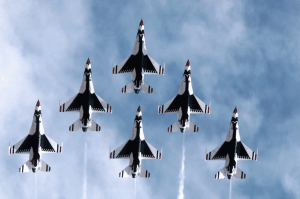General Dynamics F-16 Fighting Falcon
Technical data is for F-16C/D

Photo from USAF Homepage

The F-16 and F-15 were developed by the United States in the 1970's as replacements for the aging F-4 Phantom and the remaining Century Series Fighters of the 1950's. In the early 1970's the USAF was beginning to feel a lack of funding and thus felt the need for cheaper fighter aircraft. The Americans felt it would be more beneficial to have two light fighters than one heavy. The air force was also interested in a highly maneuverable fighter which could out fly anything the MiG or Sukoi bureaus could concoct. The competition centered around two entries. The Northrop YF-17 Cobra (which ultimately became the F-18) and the General Dynamics Model 401. The YF-17 had two engines and the 401 had only one. Normally this would be an advantage because two engines are more reliable than one. However, the Model 401, now the YF-16, won because its used the Pratt & Whitney F100 turbofan engine; the same engine used to power the F-15 Eagle. The use of the same engine to power both the F-15 and F-16 (let's all be thankful it's a damn fine engine) translated into big savings for the air force, which was after all was the name of the game. The first F-16A's were delivered to the 388th tactical fighter wing at Hill AFB in Utah in 1978. The production of the F-16A & B variants ended in 1985. The F-16C & D versions began rolling off the production line and will continue being produced through 1999. The F-16 was evaluated by Canada in the NFA (New Fighter Aircraft) competition in the early 1980's but was discarded because of its one engine, in a reversal of what happened in the states the F-18 was selected. However, the F-16 was more successful in Europe. Four countries (Belgium, the Netherlands, Denmark, and Norway) purchased and jointly produced with the US 348 F-16's to equip their air forces for the 21st century. The Fighting Falcon is used primarily in the air to surface attack role. F-16's can carry a wide variety of precision guided and conventional munitions which make them potent weapons. In the Gulf War Fighting Falcons flew more sorties than any other aircraft. Known by pilots as the "Viper" (from the TV show "Battlestar Galactica") because of its shape. The F-16 incorporates modern features like fly-by-wire controls and advanced light weight construction techniques. All squadrons in the USAF have now coverted to the C/D versions, however, some A/B's remain in ANG inventories.

Specifications
(Data for F-16C/D)
Origin: General Dynamics later Lockheed Martin
Type: Multirole Fighter
Crew: C - 1; D - 2
Powerplant: One Pratt & Whitney F100-PW-200/220/229 or One General Electric F110-GE-100/129 delivering 12 150 kg (27 000 lbs) of thrust
Dimensions
Span: 9.8 m (32' 8")
Height: 4.8 m (16')
Length: 14.8 m (49' 5")
Weight: 16 875 kg (37 500 lbs)
Performance
Maximum Speed: 2 400 km (1 500 mph)
Cruising Speed:
Climb Rate:
Range: (Ferry) 3 200 km+ (2 000 miles+)
Service Ceiling: 15 000 m+ (50 000 feet+)
Armament
1x M-61A1 20mm multibarrel cannon with 500 rounds and external stations can carry up to six air-to-air missiles (Sidewinder and/or Sparrow/AMRAAM) and/or conventional air-to-air & air-to-surface munitions (LGBs, Iron Bombs, Rockets, Cluster Bombs, Napalm, etc.) & electronic countermeasure pod
First Flight: (F-16A) 1976
User(s): US (809 in service), Norway, Denmark, the Netherlands, Belgium (Initially 348 combined in service)
Production:
Unit Cost: 20 million US$ +


Photo from USAF Homepage, this is the US air force demonstration team

Go to previous aircraft 
 Go to next aircraft
Go to next aircraft


This page hosted by  Get your own Free Home Page
Get your own Free Home Page
 Return to Homepage
Return to Homepage